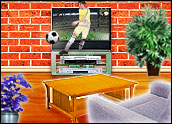
Toshiba has reportedly confirmed it is working on technology for a 3-D television set that won’t require viewers to use special glasses.
However, details are scant, and the company declined to say when such TVs will hit the market.
Toshiba isn’t alone in working on technology that will let viewers watch 3D TV without glasses.
“Every major manufacturer will be working on auto-stereo, or glasses-free, 3D TV,” David Mercer, a vice president and principal analyst at Strategy Analytics, told TechNewsWorld.
Look, Ma, No Glasses
Technology that lets people watch 3D images without glasses already exists. For example, Nintendo is using it in its 3DS handheld video game device, which it demonstrated at the E3 show in Los Angeles in June.
In the world of retail, in-store 3D displays transmit different images at various angles to create an illusion of dimension and depth, but they require viewers to stand in specific locations, and the image quality tends to be fairly low.
Mitsubishi, which is reportedly also working on glasses-free 3D TVs, will use the same technology as that in current 3D in-store displays, Yomiuri said.
“A number of auto-stereo products have been displayed at various shows recently,” Strategy Analytics’ Mercer said. “Their effectiveness can vary greatly, but at their best they can be quite impressive.”
Auto-stereo technologies are essentially stereoscopic in nature. They provide a slightly different image to each eye to enhance the illusion of depth in two-dimensional visual images. This technology was invented by Sir Charles Wheatstone in 1838.
Technical Difficulties
It’s easier to create reasonably good glasses-free 3D images on small personal displays such as the one on Nintendo’s 3DS, but doing so on larger screens is quite another matter, as the creators of in-store 3D displays have found.
“A personal display by definition is aimed at one viewer at a time, so the stereo effect is targeted to one pair of eyes,” Strategy Analytics’ Mercer explained. “One of the biggest obstacles for TV makers is ensuring that several viewers can see 3D in the same high quality at the same time, and from an infinite number of viewing angles.”
Until that problem is solved, glasses-free 3D TVs will likely not move beyond the demo stage.
“Creating an auto-stereoscopic 3D TV that more than one person can watch at one time and not be concerned about how they hold their head can be quite a challenge,” Andrew Eisner, a director at Retrevo, told TechNewsWorld. “This Toshiba TV will probably be a smaller-size TV that not too many people can watch at one time.”
Making the Nut
The next hurdle for 3D TV manufacturers is to make their technology commercially viable.
“Tackling the technical challenges is only the beginning,” Mercer pointed out. “Making the venture commercially viable is something quite different.”
That’s going to be difficult — Phillips had an “impressive” 3D TV technology that it was forced to drop because the company couldn’t figure out how to commercialize it, Mercer said.
Commercializing glasses-free 3D TV may be difficult, if buying trends for regular 3D TVs are any indication. Prices of 3D TVs have been falling, possibly because people are reluctant to cough up several thousand dollars in these tough economic times.
Fifty-eight percent of respondents to a study conducted by Retrevo in June on 3D TV sales said the sets were too expensive. Forty-three percent said they didn’t need one, while 28 percent said the discomfort caused by the special glasses needed to view 3D TV kept them from making a purchase.
Health Concerns
There’s yet another hurdle 3D TV makers face: fears of health risks posed by 3D TV sets.
“We’ve just completed a survey on 3D TV and one of the findings is the perceived health risks,” Ben Piper, a director at Strategy Analytics, told TechNewsWorld. Piper said 55 percent of respondents to the survey aren’t sure about whether or not 3D TV causes eye damage, while 17 percent believe it does.
Even Samsung, which makes 3D TVs, has warned about their health risks. Some viewers may suffer epileptic seizures or strokes, it said. Samsung suggested viewers see a doctor if they experience various symptoms, including altered vision, light-headedness, nausea, convulsions or cramps while watching 3D TV.
“All their other problems — the lack of content; the need to wear special glasses and so forth — are well and good, but this is more important,” Piper said. “There’s a perception and messaging issue 3D TV makers need to address.”
However, Piper wasn’t able to find any research definitively linking 3D TV to eye damage.
If this situation has changed by the time Toshiba brings out its glasses-less 3D TV, the company then has to commercialize the technology and market it.





















































